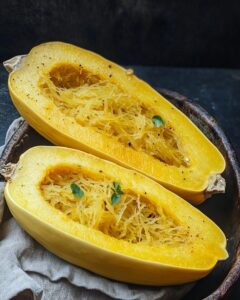Quick Spaghetti Squash with Garlic and Parmesan Recipe
Tucked away in your kitchen, spaghetti squash offers a delightful twist on traditional pasta dishes.
Nutritious strands emerge like magic when you roast this versatile vegetable.
Mild and slightly sweet, the squash welcomes bold flavors from garlic and parmesan.
Incredibly simple techniques transform this humble ingredient into a crowd-pleasing meal.
Crisp parmesan cheese adds a salty crunch that complements the squash’s tender texture.
Packed with nutrients and low in carbs, this recipe brings comfort without the heaviness of traditional pasta.
Quick and easy preparation means you can enjoy a satisfying meal in under an hour.
Dive into this scrumptious dish that proves healthy eating can be absolutely delicious.
Spaghetti Squash and Garlic Parmesan—A Match Made Delicious
Everything You Need for Flavor-Packed Squash
Main Ingredient:Seasoning and Flavor Enhancers:Garnish and Finishing Touches:How to Make Spaghetti Squash with Garlic and Parmesan
Step 1: Prepare the Oven
Set your oven to a toasty 400°F and grab a baking sheet lined with parchment paper.
Step 2: Slice and Clean the Squash
Carefully slice the spaghetti squash in half lengthwise using a sharp knife.
Remove the seeds and stringy pulp with a spoon, creating a clean interior.
Step 3: Season and Oil the Squash
Drizzle olive oil inside each squash half, then sprinkle salt, pepper, and distribute minced garlic evenly across the surfaces.
Step 4: Position for Roasting
Place the squash halves cut-side down on the prepared baking sheet, ensuring they’re flat and stable.
Step 5: Roast to Perfection
Slide the baking sheet into the preheated oven and roast for 40 minutes.
The squash is ready when the flesh becomes tender and easily separates into spaghetti-like strands.
Step 6: Cool and Shred
Remove the squash from the oven and let it cool for a few minutes.
Using a fork, gently scrape the flesh to create delicate spaghetti-like strands.
Step 7: Serve and Garnish
Transfer the squash strands to a serving bowl.
Drizzle with additional olive oil, then sprinkle fresh chives and grated Parmesan cheese on top for a delightful finish.
Smart Tips for the Best Spaghetti Squash Ever
Garlic-Parmesan Squash Twists to Try
Great Dishes to Serve with This Veggie Star
How to Keep Spaghetti Squash Fresh and Flavorful
Common Questions on Garlic Parmesan Spaghetti Squash
Spaghetti squash is a low-carb vegetable that naturally forms spaghetti-like strands when cooked, providing a healthy alternative to traditional pasta. It has fewer calories and more nutrients compared to wheat-based noodles.
Yes, spaghetti squash is naturally gluten-free, making it an excellent option for people with celiac disease or gluten sensitivity. It’s a safe and nutritious alternative to wheat-based pasta.
The squash is ready when the flesh becomes tender and easily separates into spaghetti-like strands when scraped with a fork.
Print
Spaghetti Squash with Garlic and Parmesan Recipe
- Total Time: 55 minutes
- Yield: 4 1x
Description
Delightful Spaghetti Squash with Garlic and Parmesan brings Mediterranean flavors to your dinner table with minimal effort. Roasted squash strands combine with rich garlic and salty parmesan, creating a low-carb comfort dish you’ll crave again and again.
Ingredients
Main Ingredients:
- 1 medium spaghetti squash (about 2–3 pounds / 0.9–1.4 kilograms)
- 1/4 cup grated Parmesan cheese
Seasonings and Aromatics:
- 1 teaspoon salt
- 1 teaspoon freshly ground black pepper
- 3 cloves garlic, minced
- 2 tablespoons fresh chives, finely chopped
Cooking Oils:
- 4 tablespoons extra virgin olive oil
Instructions
- Preheat the oven to a scorching 400°F, preparing for a transformative culinary experience with the spaghetti squash.
- Position the squash securely on a cutting board, skillfully trim the stem end, and divide lengthwise using a sharp knife, revealing the inner seeds and pulp.
- Meticulously clean out the squash’s interior, removing all seeds and stringy membrane with a spoon.
- Massage olive oil into the squash’s exposed flesh, ensuring complete coverage, then generously sprinkle with salt, pepper, and finely minced garlic for an aromatic infusion.
- Strategically place the squash halves cut-side down on a parchment-lined baking sheet, creating an ideal roasting environment.
- Roast in the preheated oven for 40 minutes, allowing the squash to transform until the flesh becomes tender and easily separates into delicate strands.
- Carefully extract the baking sheet from the oven and let the squash cool slightly to make handling more comfortable.
- Using a fork, gently rake across the squash’s interior, creating signature spaghetti-like strands that magically separate from the skin.
- Transfer the gossamer strands to a serving dish, drizzle with remaining olive oil, and crown with a sprinkle of fresh chives and a generous dusting of Parmesan cheese.
Notes
- Precision Cutting: Use a sharp, sturdy knife and steady hand when slicing the squash lengthwise to ensure even cooking and safe preparation.
- Oil Distribution: Massage olive oil thoroughly inside the squash halves to enhance flavor absorption and prevent sticking during roasting.
- Doneness Check: Test squash tenderness by gently piercing with a fork; strands should separate easily without resistance.
- Versatile Serving: Transform this dish into a low-carb pasta alternative by adjusting toppings like adding roasted vegetables, grilled chicken, or switching to vegan Parmesan for dietary preferences.
- Prep Time: 15 minutes
- Cook Time: 40 minutes
- Category: Dinner, Lunch, Snacks
- Method: Roasting
- Cuisine: Italian
Nutrition
- Serving Size: 4
- Calories: 180
- Sugar: 1 g
- Sodium: 250 mg
- Fat: 14 g
- Saturated Fat: 2 g
- Unsaturated Fat: 11 g
- Trans Fat: 0 g
- Carbohydrates: 8 g
- Fiber: 2 g
- Protein: 4 g
- Cholesterol: 5 mg




Truc Tran (Kris)
Senior Food Editor
Expertise
Home Cooking, Meal Planning, Recipe Development, Baking and Pastry, Food Editor, Cooking-video Maker, Vietnamese Food Evaluation Expert
Education
Truc Tran (Kris), an experienced food writer and editor, is great at exploring and describing global cuisines, from simple street food to fancy dining. In her writing, she skillfully mixes different flavors, cooking methods, and culinary traditions, showing the unique character of various cultures through their food and drinks. On azcuisines.com, Kris highlights her knowledge, especially in Asian cuisine and worldwide traditional dishes.